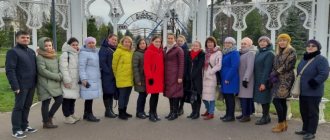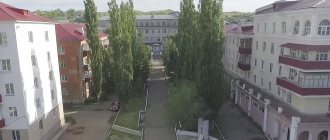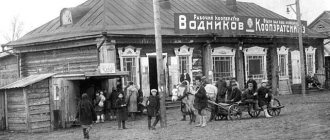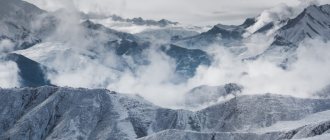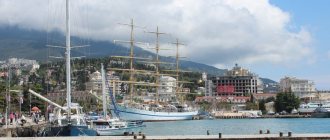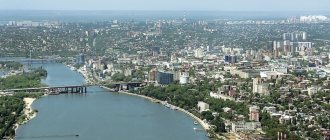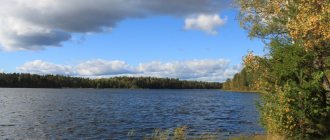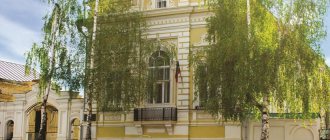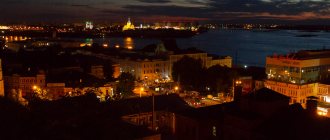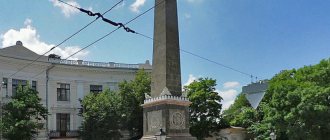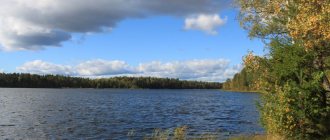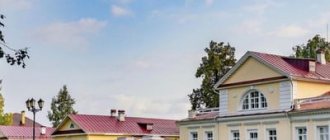When traveling around the Leningrad region, you should definitely look into Sestroretsk, a resort town on the northern shore of the Gulf of Finland. Its versatility in terms of attractions is impressive. Here you can find literally everything: ancient manors, fascinating museums, beautiful beaches and natural parks of amazing beauty. Below is a detailed guide to the best tourist places in Sestroretsk, which are very popular among city guests arriving here from all over the world.
What you should definitely see in Sestroretsk
All the sights of Sestroretsk are interesting in their own way, but some of them deserve special attention - these are the so-called “calling cards” of the city, which are its pride. What’s important is that you can watch them even in one day.
Park "Dubki"
- Coordinates on the map: 60.089240, 29.931763.
The Dubki Park has existed since 1724, its founder was Peter I himself. Initially, the oak grove played a production role. Young oak trees were grown in it, which were later used in the construction of ships of the Russian fleet. Later, gardens with fruit trees were laid out here, walking terraces were paved, protective dams were built and an imperial palace was erected, which has not survived to this day.
Today the oak grove is included in the list of World Heritage Sites and is one of the most significant natural parks in the Leningrad region. The vast area of 60 hectares is home to thousands of oak trees, many of which were planted under the Romanovs. These centuries-old trees have become symbols of Sestroretsk. An oak branch with acorns is depicted on the city's flag and coat of arms.
A walk through the park is a great opportunity to spend time in nature, breathing the fresh, clean air of the grove. There are also a lot of monuments and attractions here. The most famous of them:
- Dutch garden. It was founded in the 20s of the 18th century. All that remains from the previous layout are borders, outlines of flower beds and alleys, and pedestals overgrown with grass where marble sculptures once stood. The territory is crossed by canals flowing into a round lake. Ancient stone bridges with carved railings span them.
- Sports stadium. Dubki is a popular place for sports. There are football fields, tennis courts, an ice skating rink, and an equestrian center.
- Monument to Peter the Great. A monument dedicated to the founder of the park is installed on one of the alleys. Cast in bronze, the emperor is depicted in simple clothing. In one hand he clutches an ax and with the other he holds an oak log. So the sculptor wanted to show that Peter I was directly involved in cutting down trees for the construction of ships.
Dubki Park is a cultural and historical center and a venue for public events - holidays, rallies and sports competitions.
Temple of the Holy Chief Apostles Peter and Paul
- Address: Petrovskaya embankment, 1.
The first Peter and Paul Church in Sestroretsk was built in 1725, but burned down after five years of service. The temple was restored in the second half of the 19th century with funds allocated by Alexander II. The stone church became one of the most impressive buildings in Sestroretsk in those years. Its dome and tented bell tower rose above the modest one-story huts and were visible from afar.
Over the course of a hundred years, the temple area was transformed; a small square was created around the building, trees were planted and several chapels were built. But with the advent of Soviet power, we had to say goodbye to all this beauty. The church was demolished and a school was built in its place, which is still in operation today.
The modern temple bears the name of its predecessor, but stands in a different place - on the picturesque shore of Petrovskaya Embankment. It was erected in 2002. This is a white stone building in the style of ancient Russian architecture.
Next to it rises a bell tower with a hipped roof. The architecture of the temple is modest; it is not characterized by pomp and pomp. But the Peter and Paul Cathedral is the main religious building and one of the most recognizable landmarks of Sestroretsk
Sestroretsk border
- Address: Primorskoe highway, 309.
The Sestroretsk border is a memorial and exhibition complex located on the territory of the Sestroretsk battalion, which defended the city during the Great Patriotic War. The exhibition of the complex consists of authentic military equipment used by Red Army soldiers in battles in the vicinity of Leningrad.
Among the exhibits you can see the following objects:
- “Firing point based on the T-38 tank” is an inverted tank placed on a wooden pedestal. The internal components of the vehicle were almost completely destroyed (only the cartridge box survived), but on the outside of the hull there were traces of gunshots, and a hand-carved number was visible on the front plate.
- “TOT with KV-1 turret” is a tank fire turret with a 76 mm cannon. The machine gun was badly damaged in one of the battles: traces of hits are visible.
- “Finnish firing point for casemate gun 45K40” is a reinforced concrete wall that belonged to a bunker. After the end of the war, the gun was dismantled - it was dismantled into parts and taken out of the city. In the fall of 2010, all parts, including the firearm barrel, were found and returned to their homeland. After restoration, the weapon acquired an appearance close to its original appearance.
However, these are just some of the exhibits from the extensive collection of the memorial and exhibition center. In fact, each of them is of historical value.
The city of Sestroretsk is a climatic balneological mud resort. Located in the Kurortny district of St. Petersburg . Located in the south of the Karelian Isthmus, on the northern shore of the Gulf of Finland of the Baltic Sea, 35 km northwest of the center of St. Petersburg .
The population of the city in 2010 was 37,248 people.
About 3000-3500 years ago, a prehistoric man appeared at the mouth of the Sestra . This is evidenced by archaeological finds in the bases of the dunes near the western shore of Lake Sestroretsky Razliv, first discovered in 1905. Now eleven sites of ancient man from the Neolithic (New Stone Age) times have been found in this area.
The coast of the Gulf of Finland since the 12th century. More than once it became the object of military conflicts between the Russians and the Swedes. It was only as a result of the Northern War in May 1703 that Peter I managed to recapture these lands, including the mouth of the Sestra River. Here Russian troops defeated the twelve thousandth army of the Swedish general Kroniort.
To gain a foothold on these lands, a harbor was built in 1706 near the mouth of the Sestra River. In 1710, an expedition was sent to these places with the goal of finding iron ores and drawing up a map of the area.
The new history begins on September 20, 1714, with Peter I Sestra River . The Emperor ordered the construction of a summer palace on the shore of the Gulf of Finland , and a garden nearby. The palace was built in 1719-1724 from locally produced bricks (it would have been dismantled in 1781).
A few years later they decided to build a dam on the Sestra . The dam began to be used for a different purpose, as the long Northern War created a need for increased weapons production. In June 1721, the construction of an arms factory began under the leadership of the commander of the Olonets factories, Colonel Wilhelm (Willim, Vilma) Gennin.
Sestroretsk craftsmen made the famous “Papa’s car” based on the drawings of M.V. Lomonosov , as well as a silver shrine intended for the relics of Alexander Nevsky .
In 1721, simultaneously with the construction of the Arms Factory, a wooden Peter and Paul Church ; after the fire of 1730, it was rebuilt in another place.
During the Russian-Swedish war of 1741-1743, fortifications were built in Sestroretsk . The earthen fortifications were renewed during the Crimean War of 1853-1856, and in June 1855 the city withstood bombardment by the Anglo-French fleet.
After the fire on July 15, 1868, when the city almost completely burned out, on July 12 (24), 1871, a new stone Peter and Paul Church , built according to the design of the architect G.I. Karpova. In the same year, on November 2, traffic opened on the Beloostrov- Sestroretsk railway line.
After the construction of the Primorskaya Railway, Sestroretsk became the largest recreation center on the entire coast of the Gulf of Finland . In 1896, on the initiative of one of the leaders of the Primorsky St. Petersburg Railway, Peter Aleksandrovich Avenarius, preparations began for the construction of a balneological resort here.
Around the same years, the Kursaal (a complex of buildings that included a concert hall, a casino, a hotel, a restaurant, and a library) was built on the shores of the Gulf of Finland , which was an original wooden structure of three interconnected buildings. In the central one there was a concert hall with 1,500 seats, whose acoustic characteristics were not inferior to the best halls in Europe. Fyodor Ivanovich Chaliapin often performed at the Sestroretsk Kursaal .
In July-August 1917 on Lake Sestroretsky Razliv V.I. Lenin and G.E. Zinoviev was hiding from persecution by the Provisional Government.
the state border with Finland passed 2 km north of the city of Sestroretsk
Since 1922, the Sestroretsk arms factory has changed its profile, becoming instrumental.
By the decision of the All-Russian Central Executive Committee of June 16, 1925, the villages of Duny, Ermolovskaya, Kurort, Razliv, Tarkhovka and Aleksandrovskaya were annexed to Sestroretsk , and it itself received the status of a city.
During the Great Patriotic War, the front line was located Sestroretsk In September 1941, Soviet troops stopped the advance of Finnish troops on the approaches to Sestroretsk . The border of resistance ran along the Rusty Ditch at the 39th kilometer of the Primorskoye Highway, here the tank breakthrough of the Finnish army was stopped and the line of the Sestroretsk defense passed here. From this line in June 1944, Soviet troops launched a counteroffensive.
During the Great Patriotic War, the wooden Kursaal in the Sestroretsky Resort sanatorium was completely destroyed. The medical complex of the sanatorium reopened its doors after major renovations only in 1954.
In 1969, a new mud bath was built in the Sestroretsky Resort sanatorium. In 1978, a 10-story building with more than 500 seats was built there. The building also houses a dance hall, a conference room, and a library.
In 2001, after a major renovation, the only swimming pool with mineral water in St. Petersburg opened in the Sestroretsky Resort sanatorium. In 2008, at the All-Russian forum “Zdravnitsa-2008”, the sanatorium became the winner in the category “Best Balneotherapy Hospital”.
Sestroretsk today is, first of all, a resort town. His priority is the development of the sanatorium and resort sector. in Sestroretsk , for example, the sanatoriums “White Nights”, “Sestroretsk Resort”, “Dunes”, etc.
Several watercourses flow through the city, connecting Lake Sestroretsky Razliv and the Gulf of Finland ( Sestra , Gagarinsky Stream, the so-called Rusty Ditch). Within the city’s boundaries is Lake Sestroretsky Razliv , artificially created during the construction of a dam on the Sestra at the beginning of the 18th century.
Railway stations: Sestroretsk, Gorskaya, Aleksandrovskaya, Tarkhovka, Razliv and Kurort on the line St. Petersburg (Finlyandsky Station) - Beloostrov.
The city's attractions:
Sestroretsk to monuments of wooden architecture, unique architectural ensembles of modern times, as well as untouched northern nature.
On a cape protruding into the Gulf of Finland there are the Sestroretsk “Oaks” (1719, architect S. van Zwieten, garden master O. Udelfelt) - a park with a Dutch garden, hydraulic structures and a defensive rampart.
One of the city's attractions is the Dune nudist beach.
On June 14, 2004, the ceremonial foundation stone of the Church of Saints Peter and Paul, Equal-to-the-Apostles, .
On September 16, 2000, in Sestroretsk, in the park on Freedom Square, a monument to the founder of the city, Peter I, (sculptor V.A. Petrov, architect V.S. Vasiliev).
September 18, 2001 at the intersection of the street. Mosina and st. Voskov unveiled a monument to the Russian designer and organizer of small arms production S.I. Mosin (sculptor B.A. Petrov, architect A.G. Bakusov).
September 14, 2003 in the park near the Central District Library on the street. Mikhail Mikhailovich Zoshchenko was unveiled (sculptor - V.F. Oneshko, architect - N.N. Sokolov).
In December 2002, at the intersection of the street. Kommunarov and Dubkovskoe Highway, a monument to the legendary Soviet football and hockey player Vsevolod Mikhailovich Bobrov was unveiled.
Destroyed tuberculosis hospital - next to Razliv station.
The mansion in Sestroretsk (20th century, Grigorieva Street, 4) is a wooden mansion.
The Sestroretsk gazebo is a wooden gazebo that was for many years a calling card, a symbol of the city, but is now in ruins. Now an exact copy of the gazebo has been installed on Tokarev Street.
The dacha of E. F. Vazhevskaya (1907, Andreeva Street, 12) is a wooden dacha in the traditions of Russian folk architecture with elements of modernism.
Dacha of Ya. M. Goldenov (1908, architect S. G. Ginger, M. Gorky Avenue, 20)
Dacha Klyachko (1908, architect S. G. Ginger, Lesnaya street, 7)
Dacha of S. I. Dvorzhetsky (1909, architect S. G. Ginger, Orangery street, 3)
Telephone code: +7 812
Official website of the city: www.sestroretsk.org
Multifaceted Sestroretsk museums
Excursion tourism is the main direction of Sestroretsk. Not a single sightseeing tour of the city would be complete without visiting museum exhibitions, which will be discussed in the next section.
Ostap Bender People's Literary Museum
- Address: Tokareva street.
Ostap Bender is a famous hero of Russian literature, written by writers Ilf and Petrov. A museum named after him appeared in Sestroretsk in 2005. Its founder is A.V. Kotov was a big fan of Bender and collected all sorts of items related to the stories of his adventures.
Over time, the collection grew to the level of a museum exhibition. It included things from the 20-30s of the XX century, which in appearance were very similar to the objects involved in the stories of Ilf and Petrov, for example, Ippolit Vorobyaninov’s pince-nez, Ostap’s cap, walnut chairs, a sculpture of a golden calf and other “props” that were easily recognizable readers of stories about Bender.
A.V. Kotov was often asked why the Ostap Bender Museum was located in Sestroretsk if the events of the stories took place in completely different places. The fact is that shortly before the opening of the exhibition, Kotov conducted a personal investigation, during which he found out that the prototype of Ostap Bender could have been Osip Shor, who lived near St. Petersburg in post-revolutionary times.
The literary exhibition is located in the central library building. At the entrance, visitors are greeted by the bronze Ostap Bender. Next to the sculpture there is a chair cast in metal from the story “The Twelve Chairs”, on which you can sit and take a photo.
Museum "Lenin's Hut"
- Address: road to Lenin's Shalash, 3.
In the summer of 1917, Vladimir Lenin and Grigory Zinoviev were hiding from arrest in the vicinity of Sestroretsk. Then they had to live in makeshift huts, pretending to be Finnish mowers. After the end of Lenin's underground life, local residents wished to preserve the hut he left behind as a monument.
The original dwelling, built by the fugitives from branches and straw, naturally, has not survived to this day, but today an exact copy of Lenin’s hut is installed in that place. Next to it there are other monuments: a granite bust of the leader and a stone model of a forest hut. The museum is in demand among foreign tourists, and supporters of communism organize rallies here.
Museum-Estate of I.E. Repin "Penates"
- Address: Primorskoe highway, 411, Repino village.
Not far from Sestroretsk, in the village of Repino, lived the artist Ilya Efimovich Repin. Penaty is a wooden manor founded in 1899. A special feature of the house is the layout of its roof, which combines all kinds of construction variations and decorative elements: mezzanines, glazed tents, barrels, gentle and steep slopes.
Repin created many of his works in this estate, and today it exists as a museum dedicated to his work. In the halls of the house there is an art gallery and a residential atmosphere has been recreated. Household items, furniture, working tools and personal belongings of the artist are preserved here.
A tour of the museum includes not only viewing the paintings, but also a walk through the park, where ancient towers, wells and gazebos are preserved among deciduous groves, but most importantly, here is the grave of I.E. Repina. The artist lived in the estate for 30 years and wished for it to become his last refuge.
Museum Saray N.A. Emelyanova
- Address: st. Emelyanova, 3.
This is probably the most interesting museum in Sestroretsk, at least that’s what it has become in recent years. Located on the shores of Lake Sestroretsky Razliv, it regularly prepares unique exhibitions and expositions for visitors, which will be interesting to visit with children or in the company of adults. A lot of information can be learned here about the events of 1917, when the Bolsheviks came to power in our country through the Revolution.
Main directions
Electric trains in the Finnish direction run to Sestroretsk - regular trains and Lastochka trains. Here you can see the schedule of commuter trains in this direction.
Electric trains
The Tutu service will help you find out the schedule for the most popular routes. Electric trains. Trains from Sestroretsk depart every 30–40 minutes. The first trains leave for Finlyandsky Station at 05:58, the last flight at 22:59. Traffic towards Beloostrov is carried out from 00:28 to 22:59.
- Sestroretsk - St. Petersburg (Finland Station)
- Sestroretsk — Beloostrov
- Sestroretsk - Alexandrovskaya
- Sestroretsk - Razliv
- Sestroretsk – Resort
- Sestroretsk - New Village
- Sestroretsk - Old Village
- Sestroretsk - Yacht
- Sestroretsk - Lanskaya
- Sestroretsk - Gorskaya
Hotels near Sestroretsk railway station
© Ekaterina Borisova
Ancient dachas in Sestroretsk
At all times, people, tired of the bustle of big cities, dreamed of seclusion in the bosom of nature. That is why in provinces like Sestroretsk there are many estates - houses where noble families spent quiet days away from the noise of capital St. Petersburg.
Dacha Goldenova
- Address: st. Maxim Gorky, 20.
Yakov Mikhailovich Goldenov is a Russian writer of the 19th-20th centuries. In 1908, he hired the architect Sergei Ginter to build a country dacha for his family. The log building, hidden in the middle of a coniferous forest, became a cozy family nest and served as a home for Goldenov’s heirs before the revolution.
In 1970, the Sestroretsk holiday home settled in the estate, which operated for many years. The building gradually fell into disrepair, and a fire in 2009 seriously damaged its structure. The ruins of the house were demolished, and in their place a new building was built - a copy of the ancient estate, which today is recognized as an object of regional significance.
Dvorzhetsky's dacha
- Address: Oranzhereynaya st., 3.
Another creation of Sergei Ginter belonged to the notary S.I. Dvorzhetsky. This is a wooden manor with an attic, built in the Art Nouveau style at the end of the 19th century. Despite its age, the house has retained its delights: rectangular windows with small glazing, semi-columns and carved decorations.
After Dvorzhetsky's death in 1913, the dacha changed owners several times. For some time, the famous opera singer L.V. Sobinov lived there. Today, the building of this attraction is recognized as an object of historical and cultural heritage and is in good condition.
Businesses and work in the area
There are few large enterprises located in the region, only 11. Of these, we can highlight Kurortenergo OJSC, Sestroretsk Bakery Plant, Sestroretsk Tool Plant and others. There is practically no hazardous production in the Kurortny district.
Sestroretsk Bakery
The main sources of income in the area are hotel complexes and recreation centers (there are more than 40 of them in the area), which, after some decline at the end of the last century, are now experiencing another rise.
Recreation center
Hotel
Since the Resort District was and is a favorite vacation spot for citizens, the entertainment and sports industry also occupies a fairly strong place in the economy of this administrative unit. Equestrian tourism, karting centers are developing, numerous organizations offer their services for planning corporate and family vacations, here you can play paintball, golf, and in the warm season, ride a yacht or buggy. There are also a variety of restaurants and cafes.
Country restaurant on the way to Zelenogorsk
Sestroretsk temples and churches
In addition to religious and educational activities, the churches of Sestroretsk perform another function - they serve as monuments to history and religious architecture of different eras.
Temple of the Holy Great Martyr and Healer Panteleimon
- Address: Tarkhovsky Avenue, 32.
Panteleimon Church was built at the beginning of the 20th century. It resembled a wooden tower from a fairy tale. This effect was created by bright colors and sloping roofs with lace cornices.
A double staircase with canopies supported by narrow columns led to the front porch. A tented bell tower topped with a gilded dome rose above the main building. The church existed until 1937. Then she was beheaded, the bells and domes were melted down, and the rector of the church was arrested and taken to prison in his cassock.
The headquarters of the NKVD was located in the building of the former temple, and the court functioned. Criminals sentenced to death were shot in the backyard, and then they were buried in mass graves in the church cemetery.
During the Siege of Leningrad, convicts had it even worse: they were not given a quick death, but were left to die in cold rooms from hunger. And their bodies were thrown in the street, unburied. After the end of the war, the building was given to the fire department, and the bell tower was converted into an observation tower.
The revival of the church took place in the winter of 1990. The building was restored and returned to its original appearance. The backyard wall where the executions took place is considered a memorial. Flowers are laid at its base and candles are lit.
Chapel of St. Nicholas the Wonderworker
- Address: Perepadskaya embankment, 2.
The chapel was erected in the early 2000s in honor of Russian submariners killed in battle. We are talking about a small log structure with a tiled dome and a white stone belfry. At the base of the building there is a capsule filled with soil from the cities where submarines were based during the Second World War, and inside the building there are boards with the names of lost submarines. The chapel stands on the picturesque shore of Lake Sestroretsky Razliv, surrounded by deciduous trees.
Historical places of the city of Sestroretsk
There are many places in this suburb that are remembered from the outstanding events of bygone days. Through such sights you can get a closer look at the history of not only St. Petersburg, but also our entire Mother Russia.
Fort Totleben
- Coordinates on the map: 60.085538, 29.847858.
This facility is located not in Sestroretsk, but in the sea opposite the city - on a small island where a defensive complex was once built. Today the fort is not used for its intended purpose - as a rule, it is of interest to tourists and travelers. Reviews from visitors strongly recommend that extreme caution be exercised when visiting the fortification, due to frequent open hatches and frequent crumbling steps.
Sestroretsk arms factory
- Address: Voskova street, 2.
At one time, an important weapons factory was located here. But today there is practically nothing interesting to see at this place - a large area where various public events are held, and a number of buildings that are closed to the public. However, many reviews still say that the place is very memorable for the history of Russia. The way it is!
City `s history
The official founding date of Sestroretsk is September 20, 1714: then, by order of Peter I, a summer palace was erected and a garden was laid out. But life was here much earlier, which is confirmed by archaeological finds. Prehistoric man lived here approximately 3000-3500 years ago. Being a strategic territory, the coast of the Gulf of Finland was every now and then a constant “bone of contention” between states, the borders often changed. The border with Sweden passed along the Sestra River, then Peter I returned the territory to the Russian state and began to strengthen its position here. For this purpose, a harbor was built here, then a dam was built on the Sestra River, then an arms factory, etc.
The history of this place is rich in events and you can find detailed information in a variety of sources. And I'll tell you a little about something else.
Monuments and sculptures of Sestroretsk
Sculptural compositions play a significant role for the city. They serve as reminders of historical events and great people.
Monument “The Hidden Vessel of Efim Nikonov”
- Address: Petrovskaya embankment, 1.
E.P. Nikonov was an inventor who created the first Russian submarine, which he called the “Hidden Vessel.” In Sestroretsk, on Perepadochnaya embankment, there is a model of the ancestor of modern submarines. In appearance, it resembles a huge barrel with windows and oars on the sides.
However, this exhibit cannot be called an exact copy, since the drawings from which Nikonov worked have not been preserved - modern designers could only guess what a submarine might have looked like in the 18th century.
Shalyapin's gazebo
- Address: Lesnaya street.
There is an opinion that the small stone gazebo was built in pre-revolutionary times. It got its name in honor of the folk singer F.I. Chaliapin, who performed in it.
The gazebo has an unusual architectural design. The carved columns, double roof and bright white and blue colors attract attention to it.
Unfortunately, age and the damp climate of the Leningrad region have a detrimental effect on the strength of the ancient structure. It is currently mothballed and awaiting reconstruction.
Monument to S.I. Mosin
- Address: Voskova street.
Sergei Mosin is a major general, a Russian small arms designer who spent the last years of his life in Sestroretsk. A monument to him appeared in 2001. It is a bronze bust of the major general, mounted on a high granite pedestal with a bas-relief in the form of two crossed rifles. Around the memorial there are lawns, flower clubs, and behind it there is a green deciduous grove.
Memorial sign to the 60th anniversary of the Victory
- Address: Unconquered Square.
In the center of Sestroretsk, in the small square of the Unconquered, in honor of the 60th anniversary of the Great Victory in the most terrible war in history, a large memorial sign was erected in 2005. In addition to the monument itself, townspeople also celebrate the square itself - people often come here for a walk and walk with their children. The cleanliness of the park also stands out.
Where to go for a walk in Sestroretsk
Sestroretsk is a well-groomed and comfortable city. Walking through its parks, squares and coastline is a pleasure.
Petrovskaya embankment
Initially, the embankment was a single walking area with a length of 460 m, but in the 1970s. Primorskoye Highway was built, dividing it into two parts. The embankment got its name in honor of Peter I. Two centuries ago, his wooden palace stood here. Peter loved the sea and preferred to build his houses as close to it as possible.
To this day, the imperial palace has not been preserved, and the development of the seaside promenade is mainly made up of the Peter and Paul Church. Petrovskaya Embankment is popular among city residents due to its landscaped walking terraces and beautiful views of Sestroretsky Razliv.
Peter the Great Square
- GPS coordinates: 60.092289, 29.973978.
Another picturesque place named after the legendary emperor is located near Freedom Square.
Peter the Great Square is a cozy corner of nature. Here, well-groomed lawns are green, aspen leaves are rustling and flower beds are fragrant. Narrow paths connect in the center of the site, where a bronze bust of Peter I is installed.
Couples with children like to spend time in the quiet park, and photo sessions are also held here against the backdrop of nature.
From St. Petersburg to Sestroretsk by car
By car you can get to Sestroretsk from the center of St. Petersburg in about an hour. It will come out faster from the northern regions, and longer from the southern regions.
If you head along the Primorskoe Highway, then along the way there will be such picturesque places as Olgino, Lisiy Nos and others. Having visited Sestroretsk, you can go further to Solnechnoye, Repino, Zelenogorsk and other famous places in the Kurortny district of St. Petersburg.
Traveling by car is especially suitable for families and friends: you can spend time together comfortably. For independent tourists, this is a good way to plan their route and not have to adapt to public transport.
You can rent a car in St. Petersburg in advance online. To do this, it is convenient to use one of the leading car rental services, Discovercars.com.
The best Sestroretsk beaches
Beach lovers will be happy to know that Sestroretsk has beautiful beaches where you can swim in the waves of the Gulf of Finland and sunbathe with all the amenities.
Laskovy Beach
- Address: pos. Sunny.
Laskovy Beach is one of the most beautiful places in Sestroretsk. The long coastline is rich in diverse landscapes: there are giant stone boulders, open forests, and clean, sandy territory with views of the endless sky and the blue waters of the Gulf of Finland.
The beach has everything you need for a comfortable stay: sun loungers, umbrellas, cafes, changing cabins, restrooms. The swimming area is fenced with buoys. There is an observation tower nearby.
Ermolovsky Beach
- Address: Beach street.
The shallow water Ermolovsky beach is an ideal place for families with children. The area is kept clean: eating, littering and walking animals is prohibited on the beach. There is no rental of swimming equipment, sun loungers or sunbeds; you need to take everything you need with you.
The beauty of this place is added by the sails of yachts, which often appear on the horizon, because Ermolovsky Beach is popular among yachtsmen and windsurfers.
Sestroretsky Beach
- Address: Kupalny Lane.
This beach ranks first among the best in St. Petersburg. The coastline stretches for 2 km. The beach is sandy, there are gentle slopes leading to the water, the entry into the water is small pebbles.
The beach infrastructure includes rental of swimming equipment (including water skis), cafes, sports grounds, changing cabins and toilets.
The only downside of the place is its crowdedness. However, by visiting the beach on weekdays, you can avoid the crowds and spend time in solitude.
Sestroretsk now
Sestroretsk is located in the south of the Karelian Isthmus, located between the Gulf of Finland and Lake Ladoga. Administratively, it belongs to the Resort District of St. Petersburg and is considered a seaside climatic balneological mud resort with its own mineral water and healing mud on the northern shore of the Gulf of Finland of the Baltic Sea.
In Sestroretsk there is a lake artificially created under Peter I - Sestroretsky Razliv. It is connected to the Gulf of Finland by watercourses: the Sestra River, the Gagarinsky Stream (Shipuchka) and the so-called Rusty Ditch, which received its name from local residents for the color of the water, algae and shores.
Historical districts of the city: Gorskaya, Aleksandrovskaya, Tarkhovka, Razliv, Resort and Dunes. Sestroretsk is the largest settlement in the Kurortny district, with a population of 41,160 inhabitants.
Now about my little trip...
Before the trip, I had heard a lot about the famous Dubki Park, but I decided to leave it at the end of my journey and go in the other direction.
Natural attractions in the vicinity of Sestroretsk
Sestroretsk is literally surrounded by greenery and is a wonderful eco-tourism destination. If you like hiking and traveling through virgin lands, then this city will not disappoint you.
Ecological trail “Komarovsky Coast”
- Address: Komarovo village.
The Komarovsky Coast is called an open-air nature museum. An ecological trail is a set of paths passing through the thick of a coniferous forest. Along the way, tourists encounter centuries-old trees, huge anthills, and forest inhabitants (squirrels, hares, chipmunks). Along the wooden boardwalks along which a group of travelers follows, there are stands with educational facts about the fauna and flora of this natural area.
It is not recommended to leave the marked trail. The area is full of ravines, bogs and rushing streams. In addition, it is easy to get lost in the pine forest.
A walk along the ecological trail has a healing effect. Fresh air, saturated with the smell of herbs, pine needles and resin, has a beneficial effect on physical and mental well-being. This hike is especially recommended for people who have suffered from lung and respiratory diseases. “Komarovsky Bereg” is a stunning place that can give you an unforgettable weekend in nature.
Forest Park "Sestroretskoe Bog"
- GPS coordinates: 60.111211, 30.025416.
To the northeast of the center of Sestroretsk there is this unique natural park, well-equipped for visiting even with small children. As reviews say, the combination of forest and swampy terrain here is very harmonious - the views are truly unforgettable. Wooden paths are laid over the viscous swamp, thanks to which new routes open up for lovers of hiking in the fresh air.
Crime
The criminal background of the Kurortny district can be considered relatively prosperous. The largest number of crimes is recorded, of course, in the cities of Sestroretsk and Zelenogorsk. There are car and apartment thefts, prostitution, drugs, and street robberies. Due to the large number of dachas and gardens located in the area, burglaries, “visits” from collectors of non-ferrous metals, arson and illegal occupation of homes by illegal migrants and persons without a fixed abode are regularly observed. However, most dacha and garden areas are already protected using modern alarm systems and video surveillance.
Various crimes related to real estate fraud are widespread in the Kurortny district. The land here, as mentioned above, is expensive, living in the Kurortny district is prestigious, so “black realtors” are not asleep at all levels. The methods used today are more civilized than a couple of decades ago, but the fact remains that when making a real estate transaction in the Kurortny district you should be very careful.
